Turbo: a household word in 2013. But mysterious black magic back in 1973. That’s when the badge was first attached to a Porsche 911 concept car and, almost simultaneously, written in reverse on the Tarmac-scraping airdam of a BMW 2002. A couple of years later, a Saab 99 on steroids joined the fray.
Ever since then, the five-letter word has been inseparably linked to the 911 in particular, and to the Porsche brand in general over the course of time. Which came as a bit of a surprise since those early petrol-fed, turbocharged engines combined the worst of all worlds: excessive thirst, provocative turbo lag and dubious reliability. But at the same time, forced induction stimulated all six senses thanks to its awesome rocketship thrust that was directly proportional to the often unrestrained boost pressure.
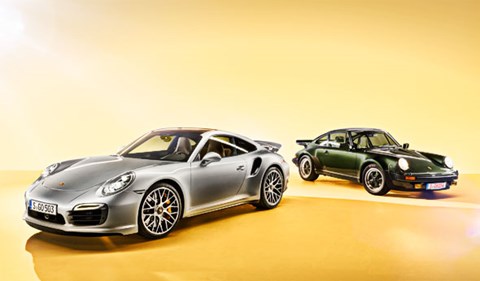
The first 911 Turbo – or 930 in Stuttgart code – will always be remembered as a challenging cannonball drive on the edge of adhesion and destiny. The latest 991 Turbo S is in all likelihood less taxing on the person at the wheel, but it matches the mighty Ferrari F12 in terms of 0-62mph acceleration, will lap the Nordschleife in a racecar-like ‘well under 7min 30sec’, and introduces such technologies as the combination of all-wheel drive and rear-wheel steering, of ground-effect adaptive front and rear aerodynamics.
For the first time, the 911 now comes in three body sizes: standard, L (Carrera 4/4S) and XL (Turbo/Turbo S). Accentuating the frame-filling posterior are four large-diameter exhaust tailpipes, a black diffuser, a pair of wraparound air extrusion louvres and of course the trademark rear spoiler that’s big enough to seat a dozen golden eagles.
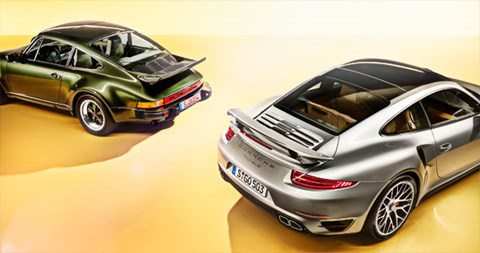
When you see the two Turbos parked side-by-side, it’s amazing how little the basic DNA has changed over time. The round headlamps still sit proud in buttock-like front wings, and the rear spoiler again shouts downforce. But although it was a substantial 123mm wider than the period Carrera coupe, the 1974 Turbo appears positively petite next to the newest iteration, which spans a beefy 1880mm where its hips are at their fullest. The new car’s screen is also far more aggressively swept back, and while there are black 15-inch Fuchs alloys with polished flanges on the vintage car (with 185/70 front and 215/60 rear tyres), there are multi-spoke, centre knock-off 20-inchers on the 2014 model. The footwear, provided by Pirelli or Dunlop, measures 245/35 up front, 305/30 out back.
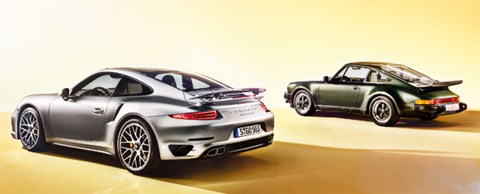
The most visible engineering evolution concerns the water-cooled model’s front-mounted radiators, which called for two relatively large nasal air intakes in addition to the breathing ducts incorporated in the rear side panels. In contrast, the front end of the 930 is all body colour with a few black rubber touches.
The blown 3.0-litre flat-six fitted in the rear of the 930 delivers 256bhp and 253lb ft of torque. That might be relatively scant by today’s lofty standards, but then so is the 1140kg kerbweight, which those 256 ponies can haul from 0-62mph in a rather rapid 5.5 seconds. Four decades later, the 1580kg 991 Turbo S requires twice as much horsepower to eclipse its great grandfather by 2.2 seconds. Maximum torque is 516lb ft at 2100-4250rpm.
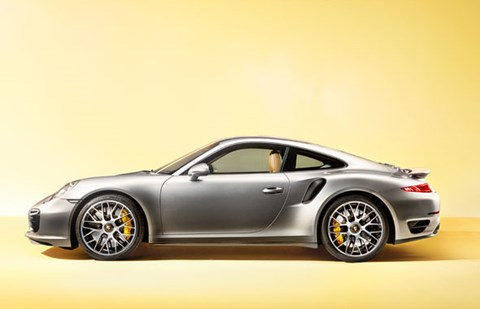
Although these numbers seem to put progress into perspective, the new Turbo is of course a hugely more sophisticated piece of kit. It musters seven forward ratios instead of just four, it will happily change up or down for you, it steers and drives all four wheels, and it is fully loaded with all sorts of electronic helpers such as radar-based cruise control and traffic-sign recognition. Why introduce four-wheel steering on a sports car and not on Cayenne or Panamera? ‘Because it turns the 911 Turbo into an even sharper weapon,’ claims Ulrich Morbitzer, the number one chassis guru at Porsche’s Weissach r&d centre. ‘The effect on the Nordschleife equals an 80bhp power boost – it really is a huge step forward in terms of grip, steering response, stability and handling quality in general. Turn-in is quicker yet feels more relaxed. Having said that, the system works very much in the background and never interferes. The only time you do notice the difference is in a parking situation where it tightens the turning circle by about half a metre.’
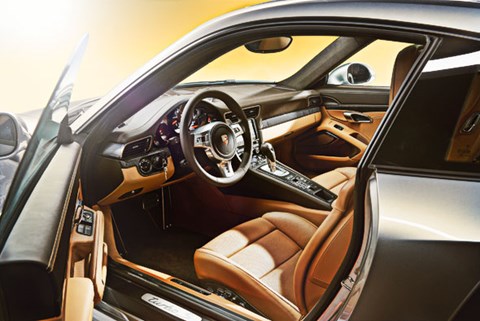
Adding a mere seven kilos to the grand total, the latest high-tech wizardry consists of two electro-mechanical actuators instead of tie rods. Depending on vehicle speed, they apply up to 30lb ft to generate a maximum steering angle of 2.8 degrees.Below 30mph, the two black boxes will encourage rear countersteer to make the car turn in more eagerly, be it through a hairpin or when manoeuvring in town. Above 50mph, all four wheels move in relative synchronicity, thereby accelerating the steering response and improving the directional stability. Says Ulrich Morbitzer: ‘Countersteer corresponds to a virtual shortening of the wheelbase by 250mm. At high velocity, the advantages of four-wheel steering equal a virtual lengthening of the wheelbase by 500mm. The system is standard on the Turbo and Turbo S and it’s a real asset, be it on the public road or on the racetrack.’
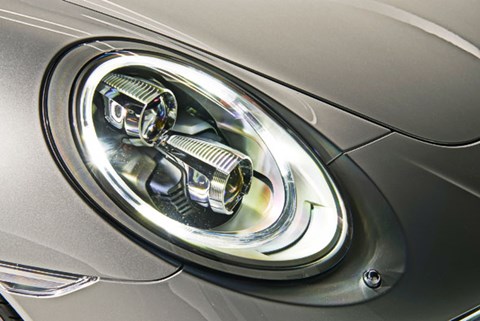
The turning rear wheels are part of the 911 Turbo’s new four-wheel-drive system, which employs a wet multi-plate clutch to distribute torque between the axles. Water-cooled and electronically controlled, the uprated all-wheel-drive technology is reportedly faster and more focused than the previous set-up introduced in the 997 Turbo.
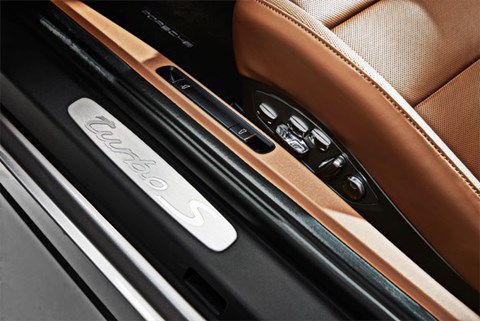
In addition, the new 911 Turbo S features active-roll compensation, the Sport Chrono Plus pack complete with dynamic engine mounts, carbon-ceramic brakes and a leather interior with 18-way memory sports seats and hide-trimmed, bucket-style backrests. Also new are LED headlamps with four-dot daytime running lights and camera-based main beam adjustment.
The direct-injection 3.8-litre flat-six is redlined at 7000rpm, boasts two variable-vane turbochargers and comes mated only with the familiar seven-speed dual-clutch gearbox. Despite a 39bhp difference in power output, the 199mph 911 Turbo S is only 0.1sec quicker from 0-62mph than its 196mph non-S stablemate, which does the job in 3.2sec. Both versions average an incredibly frugal 29mpg – a 16% improvement over theprevious model. But when you leaf back to 1977 and look upthe DIN consumption of the original 930, you will find a barely less sensational 28.2mpg. Even though the single-turbo, two-valve motor was not particularly fuel-efficient, it did perform rather well in that featherweight body.
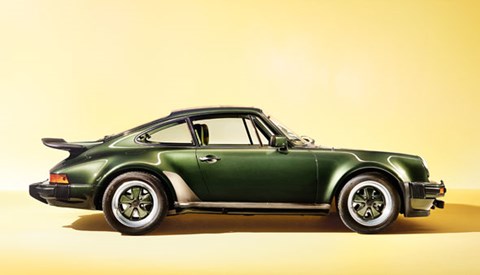
Over time, Porsche created about 20 different variations of the 911 Turbo, some hackle-raisingly radical, some limited in terms of production time or volume, some paired with specific bodystyles such as the gaudy 1982-1988 ‘slantnose’ treatment. But driving an early, no-holds-barred Turbo is always an experience, and my favourite car out of the first batch is the 1989 930 which was available in three different bodystyles: coupe (nice, if a little mainstream), cabrio (a bit too much wind in the hair) and Targa (sweet, only 104 units made). What makes this variant special is the G50 five-speed gearbox that superseded the tired old four-speeder. After 15 years of Turbo production, Porsche had sorted out most of the bugs of this inherently mean vehicle concept, but lift-off oversteer could still make you grey within a single tête-à-queue, and it took three hands and four eyes to stop the wayward Batmobile from veering into the ditch if you happened to be travelling above 130mph on the autobahn.

The 964 is perhaps the most underrated classic 911. Out of the five 964 Turbos that saw the light in the short 1990-1993 timeframe, the lightweight S built during model year 1992 was the rarest, purest and most frightening of its kind. I remember sampling this limited-edition (only 86 made) beast on the bumpy roller-coaster Stuttgart-Karlsruhe motorway which was a real test of courage at the time. Tipping the scales at 1290kg, the 3.3-litre S developed a screaming 381bhp, enough to roar from 0-62mph in 4.6sec and to reach a maximum speed of 181mph. But unfortunately not with yours truly at wheel. I briefly saw an indicated 175mph and then gave up, with weak knees and moist palms. Why? Because the car’s front end would get so light that the evident lack of downforce delayed the steering action to a point that threatened cardiac arrest.

The last of the rear-drive 911 Turbos was the 993 cabriolet of which a mere 14 pieces were completed in 1995. A few months later, Porsche introduced the 993 Turbo, the first of its kind to feature all-wheel drive and a six-speed manual transmission. That’s when the Turbo split up into two sub-families: from then on, the Turbo would be the good guy with four-wheel drive, maximum active safety and all the mod cons, while the rear-wheel-drive, turbocharged GT2 would be the bad guy with rough manners and a short temper. This dualism still lives on to this day: just wait until chief project engineer Andreas Preuninger unleashes the next GT2.
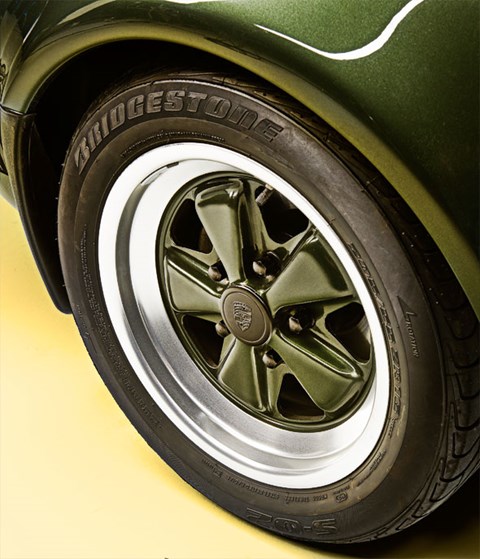
Meanwhile, we are anxious to get the keys to the new Turbo S. One of the innovations one really must try is the active aerodynamic system. The pneumatically operated front spoiler consists of three individual elements that increase the front axle downforce. The motorised rear airdam adjusts in three different positions. By pushing a button, the driver can choose between Efficiency and Dynamic mode. Efficiency reduces the drag resistance for optimum consumption and, eventually, top speed. Dynamic cuts lift to an absolute minimum, which improves the Nürburgring lap time by a couple of seconds.
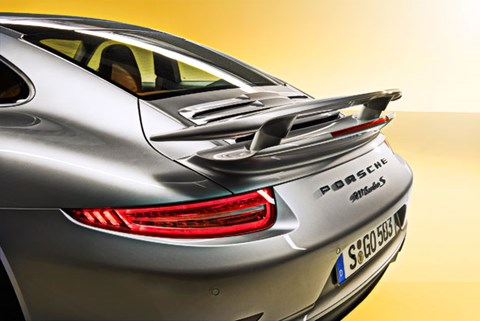
Compared with the silver 991 with its fly-by-wire aero talents, the oak green 930 is positively old-school. A rubber-lipped air dam in the front and a rubber-framed XXL air deflector in the rear are all there is in terms of wind-cheating hardware. It’s a bit like Super Constellation versus Airbus A380: an emotional encounter, but at the end of the day the new model is bound to fly circles around its iconic ancestor.
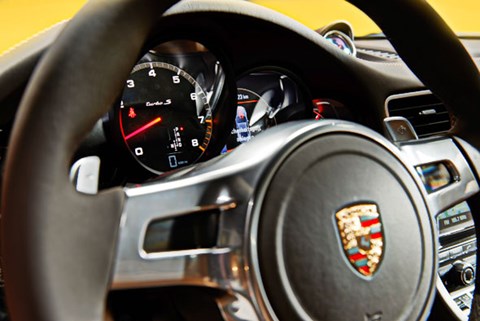
What still unites the two legends is the surprisingly similar soundtrack: underlying charger whine, intermittent wastegate whistle, occasional intercooler bubble, angry ventilator hiss. Then and now, that’s the stuff goose pimples are made of.